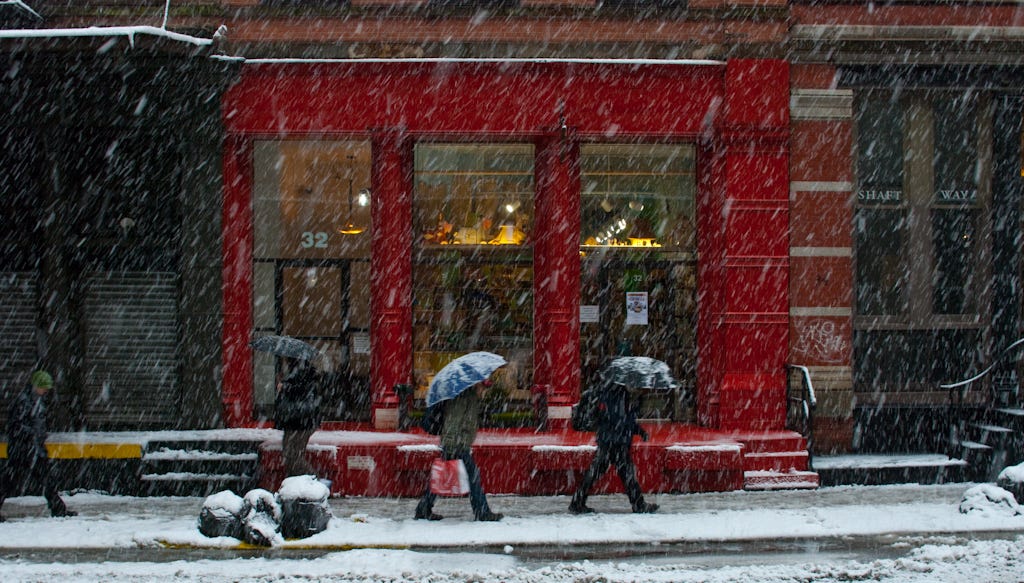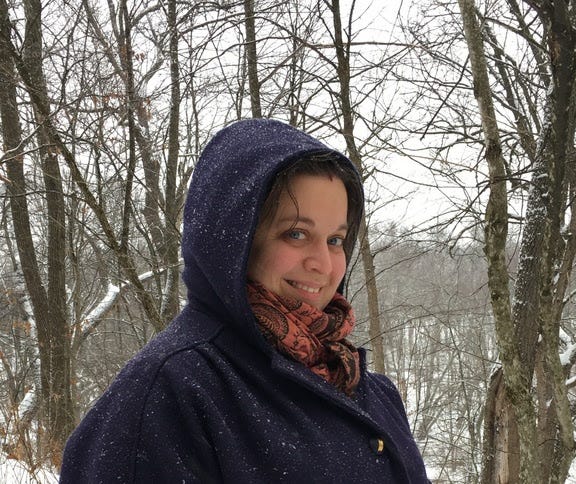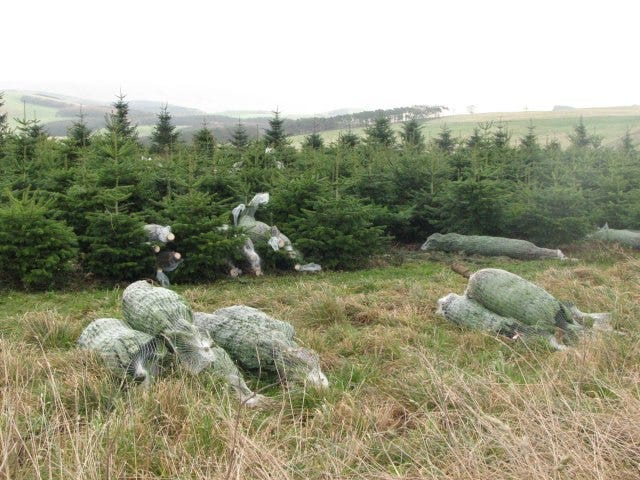November News from Elemental Tours
A Very Happy Festive Season from Erica and Charlotte!
The Ecology of the Christmas Tree by Charlotte, tales from the (icy) pavement and your new favourite book from Erica, and more!
Tales from the (Icy) Pavement
Elemental Tours got its start during the (relatively) sunny Manchester summer. Now, as the days get shorter and the winds get colder we are beginning to experience the challenges and joys (yes, there can be joy!) of doing walking tours in the cold.
Erica (pictured below all bundled up) has had many years of experience giving tours during New York City winters. Her most memorable winter experience was in early 2018. She was scheduled to give a tour of TriBeCa for Big Onion Walking Tours when the first flakes of a blizzard began to fall. Most of the tour participants canceled, but two people from Alaska showed up, saying it was basically spring weather as far as they were concerned.
The blizzard did get pretty nasty—even the Alaskans admitted that snow blowing sideways was winter weather—and the tour wrapped up early. But what was joyous about the experience was that the snow slows down the city. It gets quiet, the cars stop, and it is possible to image what it was like to live in TriBeCa when it was first being built 200 years ago.
We hope you’ll join us to experience Manchester’s wintry streets. Hats, scarves, mittens (not gloves!), thick socks, waterproof footwear, and lots of layers are key for a good winter walking tour!
New Tour Dates
If we’ve inspired you, bundle up and come and join us for our January and February tours!
All tours start at 1pm. For more info and Eventbrite links check out our website: elementaltours.com.
January 2024:
Friday 26th- More than a ‘Foul Drain’
Saturday 27th- If Stones Could Talk
February 2024:
Friday 23rd- If Stones Could Talk
Saturday 24th- More than a ‘Foul Drain’
Social Media Highlights
Follow us on Instagram to learn how modern pigeons make fossils and what transcorporeality means.
We also recommend following @Petrocultures, a hub for new ideas and insights about climate, energy, and culture.
A Recommendation for your Next Read
from Erica
Gathering Moss, by Robin Wall Kimmerer, is a book of joy and excitement—adjectives one may not expect attached to a natural and cultural history of bryophytes (a taxonomic division that includes mosses, liverworts, and hornworts). But Kimmerer’s expert melding of memoir and biology turns each moss-inspired experiment into a page-turning mystery.
This type of science writing is rare. Modern science of sterile laboratories and white coats seems to demand a dispassionate rationality. Kimmerer acknowledges that she too had been part of this world. She reminisces that when she began a biology program in college, she “got the impression that the stature of science would somehow be lessened if we included human relationships” (108).
Gathering Moss demonstrates that this need not be the case. Humans are ever-present in this book about mosses. Sometimes it is Kimmerer herself standing hip deep in the Kickapoo River or swatting mosquitoes in the Adirondacks. Other times she uses mosses as metaphors for human greed or grief.
Another unique aspect of this book is the drama that infuses Kimmerer’s narrative of her experiments. Rather than a dry accounting of the inevitable progress from hypothesis to theory, Kimmerer’s experiments begin with an observation posed as a puzzle: for instance, why does this single species of moss sometimes reproduce sexually and other times reproduce asexually? Then, like any skilled mystery writer, she leads the reader on a winding path of false assumptions, red herrings, and dead ends before finally reaching a conclusion (but no spoilers here!). For all the excitement of the chase, Kimmerer does not lose her methodological rigor.
This is the heart of Gathering Moss. The world is wide enough for multiple ways of knowing. In one slim volume Kimmerer approaches moss as a bryologist, a mother, a paid consultant, and a member of the Citizen Potawatomi Nation. Her multiple identities are not contradictory. More than once in the book she discusses the importance of human language in understanding the non-human word.
As a scientist, Kimmerer points out the gametophytes, sporophytes, acrocarps, and pleurocarps in a clump of moss, avowing that “having the words… creates an intimacy with the plant that speaks of careful observation” (12). As a steward of indigenous knowledge, she opens a chapter on the natural web of reciprocity with: “The average person knows the name of less than a dozen plants, and this includes such categories as ‘Christmas Tree.’ Losing their names is a step in losing respect. Knowing their names is the first step in regaining our connection” (108).
But while Kimmerer demonstrates that it is possible to understand moss in different but compatible ways, she sees no kinship between understanding and owning. In a chapter where she is hired as a landscaping consultant for a man wishing to recreate an Appalachian landscape in his backyard, she is increasingly disillusioned by his desire to possess—rather than enjoy—nature. “To destroy a wild thing for pride seems a potent act of domination. Wildness cannot be collected and still remain wild. Its nature is lost the moment it is separated from its origins. By the very act of owning, the thing becomes an object, no longer itself” (145).
Gathering Moss gives the reader a deeper appreciation of the tiny world of mosses and the excitement that comes from knowing it better.
The Christmas Tree- What is Natural Anyway?
from Charlotte
A festive themed blog this month from Charlotte, with a discussion of the origins of the Christmas tree! Grab a mince pie or several and settle down to consider the boundary between nature and culture in the Christmas tree.
‘Tis the season to be festive once again- but how about with a slight twist? There are plenty of articles out there talking about the origins and symbolism of the ever-popular Christmas tree. Pagan customs, Protestant Christian customs, Prince Albert, and the fire hazard of the original real candle decorations are all up for discussion.
But what about the physical Christmas tree itself. If you decide to bring a real evergreen into your life this Christmas, where does it come from?…’
Read the full piece here:
https://elementaltours.substack.com/p/the-christmas-tree-what-is-natural







